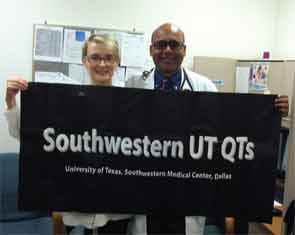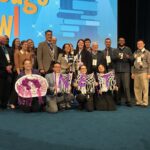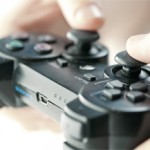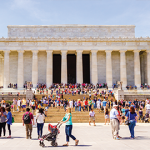
I won’t pretend. I am aware that every time the 2013 ACR Knowledge Bowl (KB) host Rebecca Manno, MD, handed a microphone to the University of Texas Southwestern (UTSW) team and said, “UT QT’s, go next,” some members of the audience giggled. We could have chosen another name, like Cowbyologics, Lone Rheum for Stars, or some other more formidable-sounding name for our Texas team, but we chose something easy and catchy. So when I heard my team being called for the first time, I thought, Oh boy—you cannot take us seriously! However, the stress of performing before a live audience and being blinded by the powerful stage lights quickly eliminated that part of my thinking process.
An Annual Tradition
The Knowledge Bowl is held during the ACR/ARHP Annual Meeting, and it is based on the format of the iconic TV game show Jeopardy. Each year, rheumatology fellowship programs assemble teams that consist of two fellows who are coached by an attending physician. Team members are designated as ACR meeting speakers and have to sign speaker agreements and provide short biographical sketches, which are used by the host to introduce each contestant. What a great way for the audience to learn something funny, embarrassing, or intimate about each player! Fellows participate in the preliminary rounds and, in the finals round, are joined by their attending physician. The stakes get higher, and points are doubled in the later rounds. As in the TV version of the game, the final question often becomes a winner-take-all situation, depending on the scores.
The topics that were covered included crystals, myositis, disease-modifying drug therapies, soft-tissue pain syndromes, and whatever else can generate a short, but challenging, rheumatology question. For the first time, this year’s Bowl included two international teams, the Guatemalan Association against Rheumatic Diseases’ AGAR Force and Saudi Arabia’s Rheum of Arabia. Aside from winning a trophy, the two finalists were awarded free registration for next year’s annual meeting, and the runner-up team won a free future “Meet the Professor” session.
As exciting as all this was, the most important aspect of the experience was the feeling I had of being an integral part of the ACR family. It was exhilarating to compete against the other teams in a fun, collegial atmosphere. The exercise of having to think on your toes can only help me in the future when faced with in-service and rheumatology board exams.
Taking the Field
I anxiously awaited our turn to play against the tough Guatemalan team. I did not know what to expect from our rivals. Would they be gentle giants or aggressive contestants, or somewhere in between? My imagination ran wild. Some of the more competitive teams studied with flashcards and appeared to be intently focused. It was interesting to watch the qualifying rounds and observe that we are all vulnerable, imperfect, and, at times, very amusing fellows. The entertainment factor of the Bowl cannot be overstated.
During the game, I transitioned from being a rather nervous to a more relaxed participant, especially after observing other teams’ trials, errors, triumphs, and losses. However, my relaxed pose quickly vanished once it was my turn to stand at the podium, in the lights, and face an audience and a barrage of questions from the host. While being introduced, I was taken by surprise by Dr. Manno’s inquiry about the first “patient” that I treated. I replied that, at age six, I claimed my brother’s teddy bear as my own. The bruin turned out to be one very sickly beast, needing frequent surgical procedures and countless injections. No doubt, this experience prepared me for medical career. The surprise revelation from my teammate, Arshad Mustafa, MD, was his fear of lizards. The horror, the horror.
The second preliminary round confirmed to me that most fellows just want to have fun. The two guys on the Mississippi Missiles team from the University of Mississippi Medical Center created a bit of a stir with their folksy drawl. They chose to replace the traditional reply to a question from, “What is … ’’ to a southern sounding, “How ‘bout …”. They charmed the audience with their wit and perfectly timed chorus of, “USA, USA,” whenever there seemed to be a need for an energy boost. For me, this was a defining moment of the Bowl, when I stopped worrying about the event and began reveling in all the excitement.
And the Winner Is…
I must pay tribute to this year’s champions, the Portlandumabs, from the University of Oregon Health and Science Center. This team was fearless, and it was clear that they were prepared to face last year’s champs from the University of Colorado, the Know Bones About It and the University of Louisiana’s Hurricane Katrinas. For the final, decisive question, all three teams showed that American spirit and bet all their remaining points on the answer. They were all correct, identifying the Gomori-Trichrome stain as the one that is used to visualize the red-rimmed vacuoles in inclusion body myositis. The Portlandumabs zoomed ahead by 400 points and were declared the victors.
I left San Diego with fond memories of the Bowl. It was such an unforgettable experience: educational, entertaining, and so social too! I think that most, if not all, of the participants learned something about themselves and their peers—and most of all, we had fun. I heartily congratulate all of the participants and hope that the champions will carry the trophy with pride and inspire their younger colleagues to bring something very special to next year’s event in Boston. At the annual meeting, knowledge comes in different flavors and through various means. The Knowledge Bowl, in its very amusing way, teaches so much more than medicine.
Dr. Gilek-Seibert is a rheumatology fellow at the University of Texas Southwestern Medical Center in Dallas.



